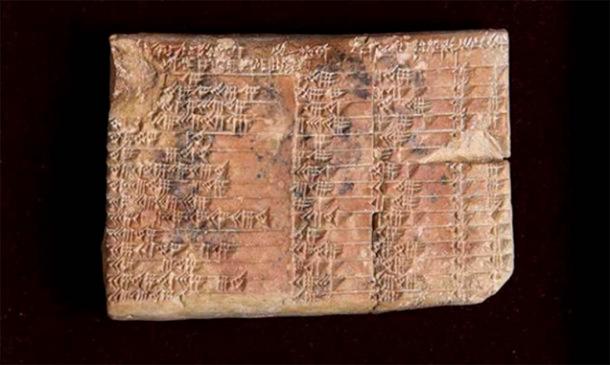One might find it curious that we divide the hours into 60 minutes and the days into 24 hours – why not a multiple of 10 or 12? Put quite simply, the answer is because the inventors of time did not operate on a decimal (base-10) or duodecimal (base-12) system but a sexagesimal (base-60) system. For the ancient Sumerian innovators who first divided the movements of the heavens into countable intervals, 60 was the perfect number.

The Useful Number 60
The number 60 can be divided by 1, 2, 3, 4, 5, 6, 10, 12, 15, 20, and 30 equal parts. Moreover, ancient astronomers believed there were 360 days in a year, a number which 60 fits neatly into six times. The Sumerian Empire did not last. However, for more than 5,000 years the world has remained committed to their delineation of time.

The celebrated Babylonian mathematical tablet Plimpton 322 at the Rare Book and Manuscript Library at Columbia University in New York. (UNSW/Andrew Kelly)
Sumerian Time
Many ancient civilizations had a rough approximation of the passage of time. Obviously, a day began when the sun rose and night began when the sun set. Somewhat less obvious was the passage of weeks, months, and years; however, these too had been approximated by ancient peoples. A month was the length of time of one complete lunar cycle, whereas a week was the length of time for one phase of the lunar cycle. A year could be estimated based on the changing seasons and relative position of the sun. Once the zenith of the sun was determined, scholars could count the number of sunrises/sunsets that passed until it reached its zenith again. In this manner, the ancient Egyptians, Mayans, and Babylonians, among others, determined that the year had 360 days. Yet it was the Sumerian astronomers and mathematicians who first systematically divided the passage of time. Their work was widely accepted and spread throughout Eurasia.
The decimal system is today the most widely used numerical base. It is a readily available system of counting, given that humans have 10 fingers on which to count. As such, there are several claimants to the invention of the decimal system, notably the Greeks (circa 300 BC), the Chinese (100 BC), and the Indians (circa 100 AD). Less well known are the origins of the duodecimal system, although it appears to have arisen independently in ancient Nigerian, Chinese, and Babylonian languages, markedly in the belief of the 12 signs of the zodiac. However, all of these were preceded by the ancient Sumerians who crafted their sexagesimal system in the 3rd millennium BC.

Early Proto-cuneiform (4th millennium BCE) and cuneiform signs for the sexagesimal system (60, 600, 3600, etc.) (Otfried Lieberknecht/CC BY-SA 3.0)
Remote islanders invented binary number system before famous mathematician Five Ways Ancient India Changed the World – With Math
The Sumerian Invention of the Sexagesimal System
The Sumerians initially favored the number 60 because it was so easily divisible. Not only were there few remainders when working with the number 60 and its multiples, the remainders that did appear did not have repeating decimals (ex. 1/3 = 0.333…), a concept Sumerians could not process at the time. The land of Sumer was conquered in 2400 BC by the Akkadians and then by the Amorites (also known as the Babylonians) in 1800 BC. Each subsequent ruling power also appreciated the user-friendly sexagesimal system and incorporated it into their own mathematics. So the notion of dividing time into units of 60 persisted and spread to the East in Persia, India, and China as well as to the West in Egypt, Carthage, and Rome. The system neatly complimented the Chinese astronomers’ work of discovering the 12 astronomical hours of the stars (a mostly theoretical discovery as most people lived by the sun). It also worked with imperial military strategies, particularly the division of the night watch into multiple even increments. The Egyptians maintained three watches each night, the Romans had four.

Babylonian tablet YBC 7289 showing the sexagesimal number 1, 24, 51, 10 approximating √2 (Bill Casselman/CC BY-SA 3.0)
With Greek and Islamic innovations in geometry, it was discovered the 360 was not only the length of time of the earth’s ideal orbit but also the perfect measurement of a circle. The sexagesimal system thus began to solidify its place in history by becoming essential for mathematics and navigation (the earth being divided into degrees of longitude and latitude). Finally, with the invention of the timepiece in the 14th century, the circular clock face was divided into neat, sexagesimal quadrants that gave each minute 60 seconds.
Top image: From Sumerian time to modern-day clocks, the number 60 has stood the test of time. Source: (Samantha/CC BY 2.0), nebula NGC 1788 Orion constellation (ESO/CC BY 4.0), Zodiac of Dendera (Alice-astro/CC BY-SA 3.0)
By Kerry Sullivan





